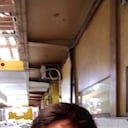Where in the human body is the 'round window'?
The round window is one of the two openings from the middle ear into the inner ear. It is sealed by the secondary tympanic membrane (round window membrane), which vibrates with opposite phase to vibrations entering the inner ear through the oval window. It allows fluid in the cochlea to move, which in turn ensures that hair cells of the basilar membrane will be stimulated and that audition will occur.
The round window is situated below and a little behind the oval window, from which it is separated by a rounded elevation, the promontory.
It is placed at the bottom of a funnel-shaped depression (the round window niche) and, in the macerated bone, opens into the cochlea of the internal ear; in the fresh state it is closed by a membrane, the secondary tympanic membrane (Latin: membrana tympani secundaria, or membrana fenestra cochleae)) or round window membrane, which is a complex saddle point shape. The visible central portion is concave (curved inwards) toward the tympanic cavity and convex (curved outwards) toward the cochlea; but towards the edges, where it is hidden in the round window niche, it curves the other way.
More Info:
en.wikipedia.org






